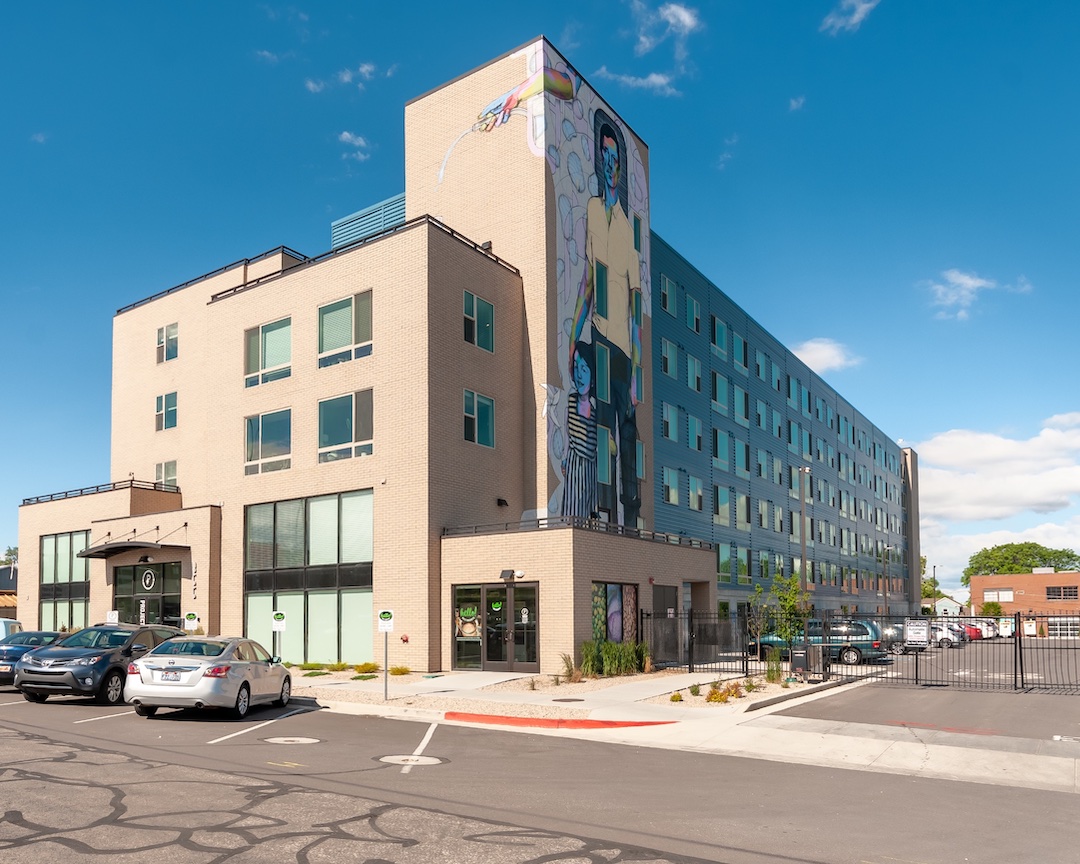The $16 million Project Open rental community of 112 one-bedroom units is the product of Giv Development, a Salt Lake City developer that specializes in mixed-income housing communities. Its not-for-profit arm explores new concepts for affordable, sustainable housing.
“We’re interested in developing a scalable net-zero model that will start to shift market dynamics and encourage developers to recognize that building this way is the economically intelligent thing to do,” said Giv Group Executive Director Chris Parker.
The all-electric building is located in the city’s Guadalupe neighborhood, an urban district on the front lines of gentrification. “We want the building to serve as a bulwark against the population being pushed out as property values continue to rise,” said Parker.
About 70% of Project Open’s units are set aside as affordable, some with rents as low as $375 a month. A historic furniture warehouse behind the building was converted into amenity spaces and 14 studio workspaces for rent by resident artists and entrepreneurs.
“I love what Giv is doing to make sure the neighborhood will remain affordable for people who have lived here for generations,” said tenant Valarie Williams. She moved into the building when it opened in January 2017 and also rents studio space for her part-time hand-lettering business. “The fact that it’s sustainable and also gives me a space in which to create was icing on a really great cake,” she said.
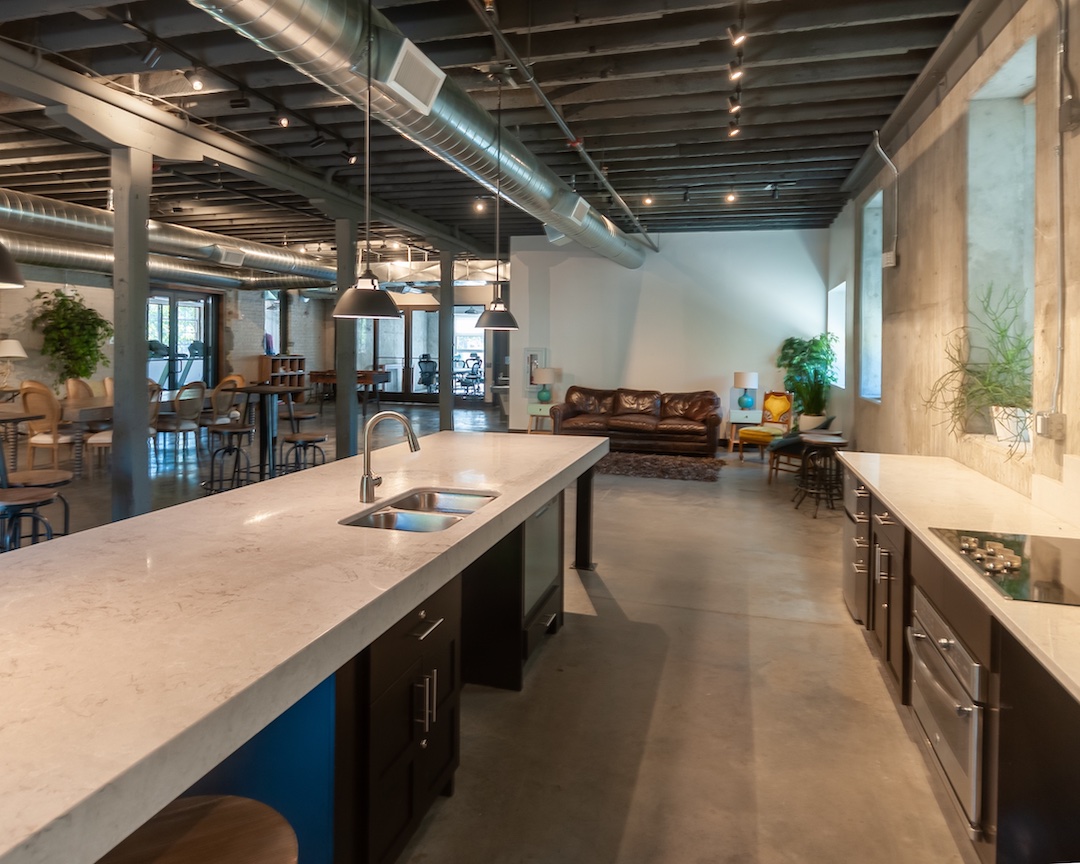 The clubhouse of Project Open resides in a historic furniture warehouse that Giv Development renovated into 14 affordable creative studios, a gym, and a conference room, in addition to the clubhouse. The reconstructed building is now another emission-free component of Giv’s Project Open complex. Photo: Brandon Hyatt Photography
The clubhouse of Project Open resides in a historic furniture warehouse that Giv Development renovated into 14 affordable creative studios, a gym, and a conference room, in addition to the clubhouse. The reconstructed building is now another emission-free component of Giv’s Project Open complex. Photo: Brandon Hyatt Photography
Goldman Sachs, Olene Walker Housing Loan Fund, and Utah Housing Corporation provided funding. Although no solar tax credits were issued, Rocky Mountain Power set up the solar program and provided transportation and energy-efficiency rebates.
Lowering carbon emissions is a high priority in Salt Lake City. Air quality is particularly poor during winter months, when prolonged inversions cause cold, stagnant air to settle in mountain basins and trap pollutants. The metro area ranked eighth nationally in so-called PM2.5 spikes, which measure small particulate matter pollutants, according to the American Lung Association’s 2019 “State of the Air” report.
Addressing the region’s air quality problems is “an issue that has to be taken up collectively or no one gets much benefit,” said Parker. “Utah’s population is expected to double in the next 30 years, so there’s a bit of urgency here.”
FINE-TUNING THE carbon neutral apartment APPROACH
Space limitations on the roof made it impossible to power the entire six-story building with rooftop PVs. Instead, residents purchase their electricity from Rocky Mountain Power’s Subscriber Solar program, via solar panels housed at a power facility in central Utah. “The program offers reliable solar production without any upfront capital costs, which provides a real market incentive to move to electrification,” said Parker.
Each residence is heated and cooled by an individual heat pump, but Giv also opted to install a supplemental resistance heating system to make sure residents can stay warm in Utah’s brutal winters. Tankless electric water heaters added to total energy demand, necessitating an upgrade to a 150-amp circuit breaker in each unit.
“It really caught us off guard how difficult and time-consuming it was going to be to route power to the units,” said Tyler Hollon, Business Development Specialist at general contractor Wadman Corporation. “We had to run six-gauge wires to each unit and didn’t really plan for enough room in the walls to make everything fit.”
Hollon anticipates all-electric buildings will become the local standard as technology advancements and construction ingenuity continue to make the project economics more appealing. “I wouldn’t be surprised if half the units will be built this way in two years,” said Hollon, whose firm is currently building about 1,200 carbon-neutral residential units throughout the Salt Lake City area.
Related content: Deluxe parking: A condo building in Philadelphia offers its owners a completely automated parking service
Project Open phase two, currently under construction and scheduled to open later this year, will offer a wider range of living options, from live/work studio apartments to four-bedroom units. The two-building complex will integrate high-efficiency mini-split heat pumps, hybrid heat pump water heaters, and no-backup resistance heating units to save energy. It will also incorporate more amenities that support a low-carbon lifestyle, such as an electric vehicle ride-share program, e-bikes, and a fresh food space to lessen the need for frequent trips to the grocery store.
A planned third phase, expected to break ground in 2020, will incorporate some condominium units.
Ultimately, Giv wants to provide local developers, contractors, and architects with real-world residential models that outperform conventional properties from an economic, environmental, and social equity standpoint. Project Open is creating a public website where it will share real-time data on each building’s energy use, construction costs, and the specific building systems and products that were used.
“We envision Project Open as an open source research tool for anyone—including us—to keep thinking about solving the challenges we currently have with the way we build,” said Parker.
PROJECT TEAM | PROJECT OPEN, PHASE ONE
DEVELOPER Giv Development
ARCHITECT Architecture Belgique
STRUCTURAL ENGINEER Canyons Structural
CIVIL ENGINEER Focus Engineering
MEP ENGINEER PVE
ENERGY CONSULTANT Provident Energy
GENERAL CONTRACTOR Wadman Corporation
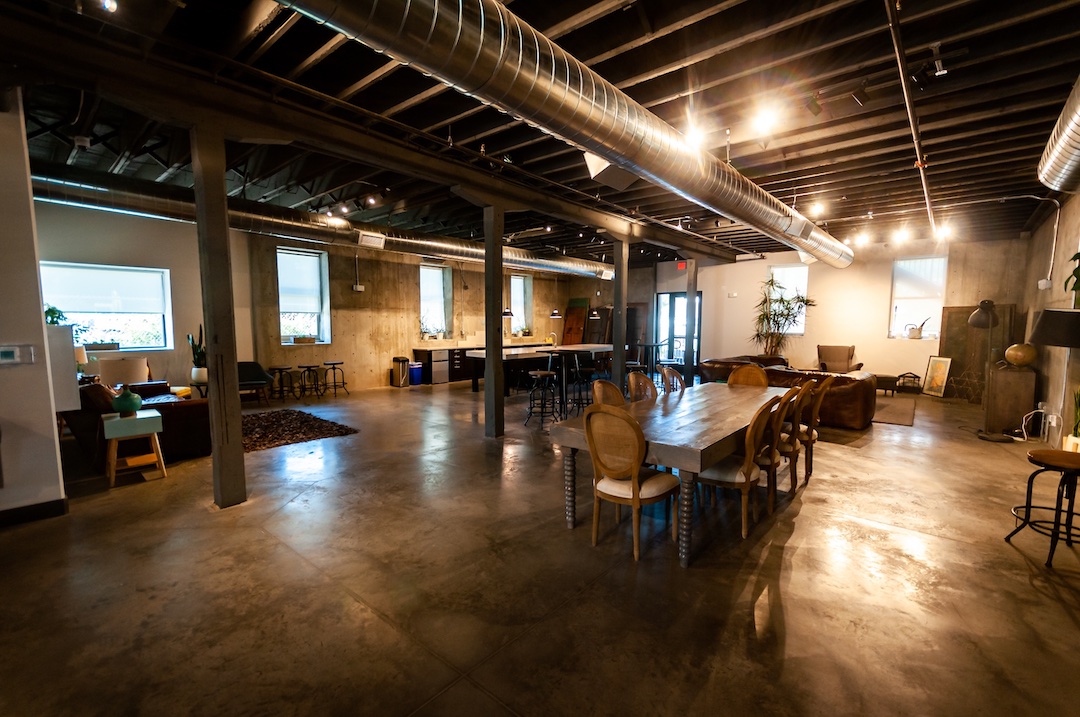 Photo: Brandon Hyatt Photography
Photo: Brandon Hyatt Photography
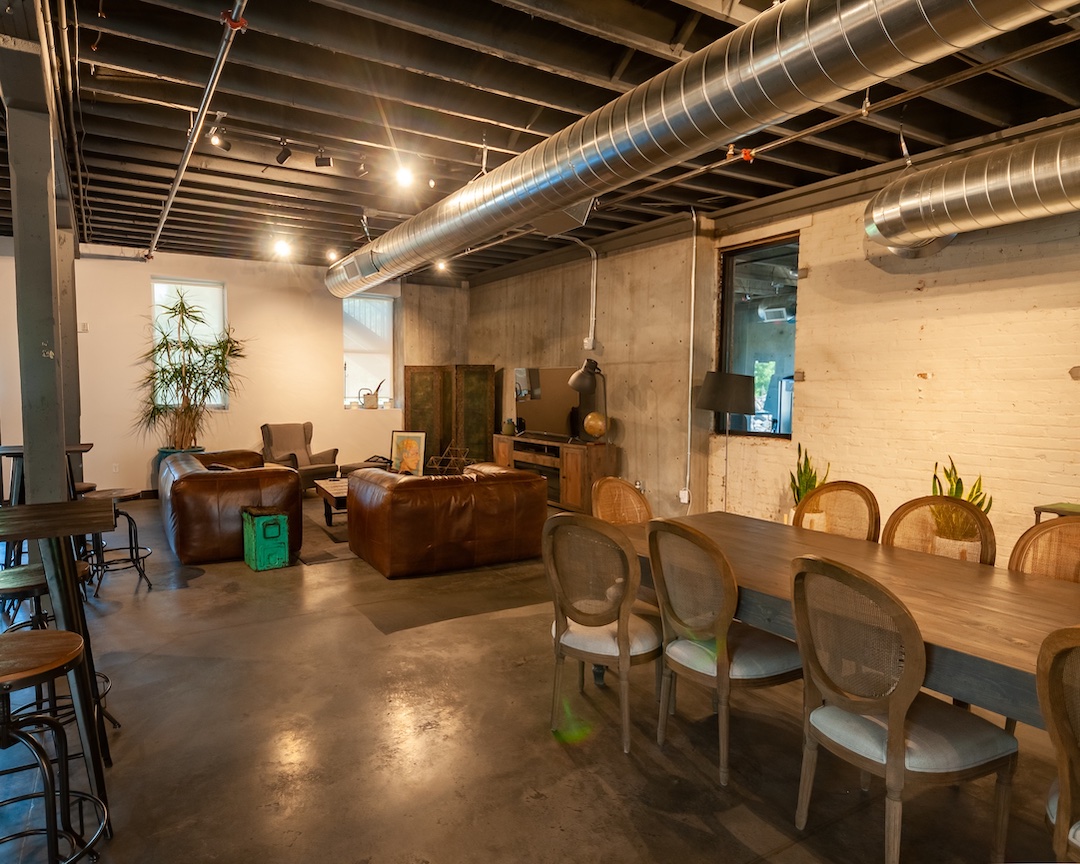 Photo: Brandon Hyatt Photography
Photo: Brandon Hyatt Photography
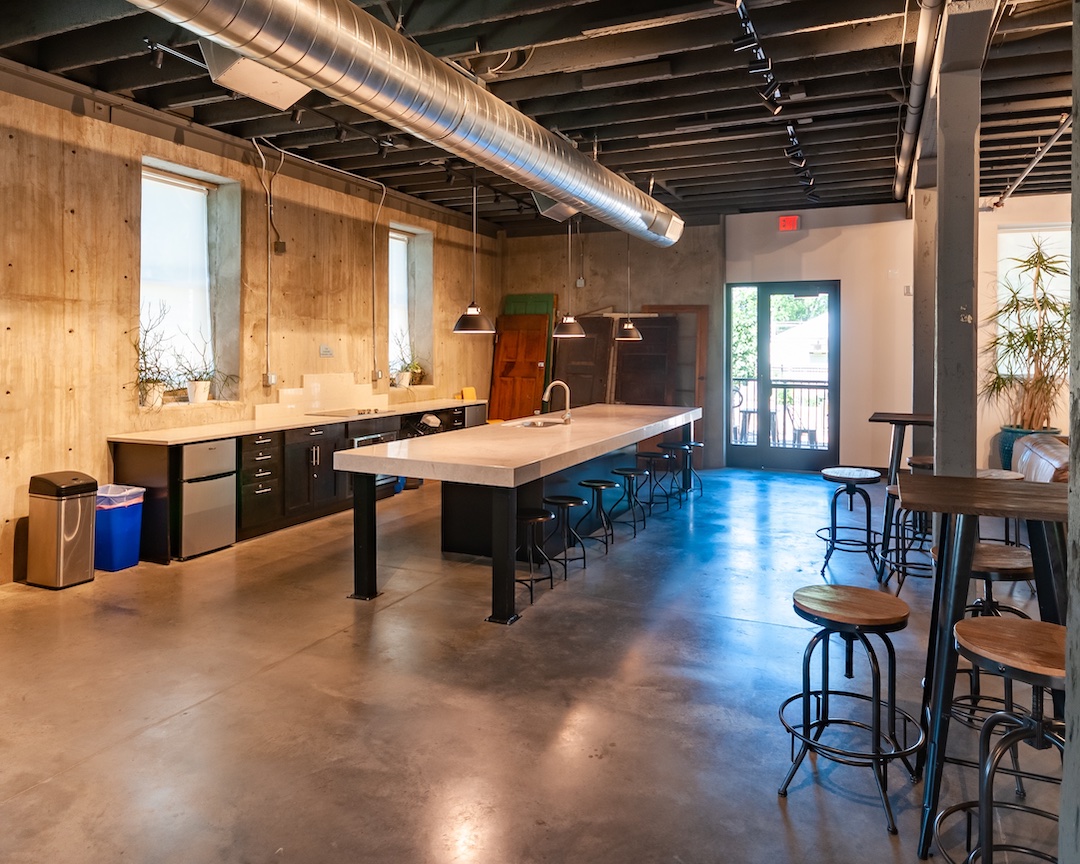 Photo: Brandon Hyatt Photography
Photo: Brandon Hyatt Photography
Related Stories
Codes and Standards | Apr 8, 2024
Boston’s plans to hold back rising seawater stall amid real estate slowdown
Boston has placed significant aspects of its plan to protect the city from rising sea levels on the actions of private developers. Amid a post-Covid commercial development slump, though, efforts to build protective infrastructure have stalled.
Sustainability | Apr 8, 2024
3 sustainable design decisions to make early
In her experience as an architect, Megan Valentine AIA, LEED AP, NCARB, WELL AP, Fitwel, Director of Sustainability, KTGY has found three impactful sustainable design decisions: site selection, massing and orientation, and proper window-to-wall ratios.
Brick and Masonry | Apr 4, 2024
Best in brick buildings: 9 projects take top honors in the Brick in Architecture Awards
The Ace Hotel Toronto, designed by Shim-Sutcliffe Architects, and the TCU Music Center by Bora Architecture & Interiors are among nine "Best in Class" winners and 44 overall winners in the Brick Industry Association's 2023 Brick in Architecture Awards.
Retail Centers | Apr 4, 2024
Retail design trends: Consumers are looking for wellness in where they shop
Consumers are making lifestyle choices with wellness in mind, which ignites in them a feeling of purpose and a sense of motivation. That’s the conclusion that the architecture and design firm MG2 draws from a survey of 1,182 U.S. adult consumers the firm conducted last December about retail design and what consumers want in healthier shopping experiences.
Healthcare Facilities | Apr 3, 2024
Foster + Partners, CannonDesign unveil design for Mayo Clinic campus expansion
A redesign of the Mayo Clinic’s downtown campus in Rochester, Minn., centers around two new clinical high-rise buildings. The two nine-story structures will reach a height of 221 feet, with the potential to expand to 420 feet.
Sports and Recreational Facilities | Apr 2, 2024
How university rec centers are evolving to support wellbeing
In a LinkedIn Live, Recreation & Wellbeing’s Sadat Khan and Abby Diehl joined HOK architect Emily Ostertag to discuss the growing trend to design and program rec centers to support mental wellbeing and holistic health.
Architects | Apr 2, 2024
AE Works announces strategic acquisition of WTW Architects
AE Works, an award-winning building design and consulting firm is excited to announce that WTW Architects, a national leader in higher education design, has joined the firm.
Office Buildings | Apr 2, 2024
SOM designs pleated façade for Star River Headquarters for optimal daylighting and views
In Guangzhou, China, Skidmore, Owings & Merrill (SOM) has designed the recently completed Star River Headquarters to minimize embodied carbon, reduce energy consumption, and create a healthy work environment. The 48-story tower is located in the business district on Guangzhou’s Pazhou Island.
K-12 Schools | Apr 1, 2024
High school includes YMCA to share facilities and connect with the broader community
In Omaha, Neb., a public high school and a YMCA come together in one facility, connecting the school with the broader community. The 285,000-sf Westview High School, programmed and designed by the team of Perkins&Will and architect of record BCDM Architects, has its own athletic facilities but shares a pool, weight room, and more with the 30,000-sf YMCA.
Market Data | Apr 1, 2024
Nonresidential construction spending dips 1.0% in February, reaches $1.179 trillion
National nonresidential construction spending declined 1.0% in February, according to an Associated Builders and Contractors analysis of data published today by the U.S. Census Bureau. On a seasonally adjusted annualized basis, nonresidential spending totaled $1.179 trillion.


